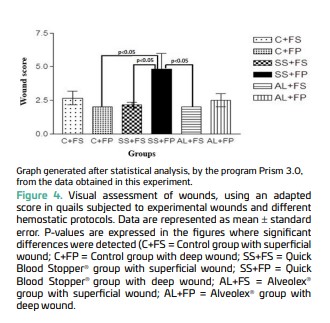Comparison of experimental wound healing in quail using two types of commercial hemostatic dressings
DOI:
https://doi.org/10.21708/avb.2021.15.2.9731Resumo
The use of powdered hemostatic products and propolis-based preparations has become increasingly common to control bleeding and aid healing. This study evaluated two hemostatic dressings, one based on propolis (Alveolex®) and the other on ferric subsulfate powder (Quick Blood Stopper®), on experimental wound in quails. The experiment was conducted with 36 quails assigned to three groups: control, propolis-based hemostatic dressing and ferric subsulfate-based hemostatic dressing, on two types of wounds, superficial (skin and subcutaneous) and deep (skin, subcutaneous and muscle). Pre- (day-7) and post-procedure (days 2 and 10) examinations showed a tendency to reduce hematocrit values on day 2 and a tendency to increase fibrinogen levels and total leukocyte count on the same day. Visual assessment of wound healing indicated that birds using Quick Blood Stopper® showed signs of poor healing, while the group treated with Alveolex® had uncomplicated healing within the expected time. The groups treated with hemostatic based on ferric subsulfate showed a tendency to increase the values of fecal corticosterone metabolites on day 10, suggesting an increased level of stress in these animals. During the surgical procedure, both hemostatic products controlled bleeding, but Alveolex® was more efficient and easy to handle.
Downloads

Downloads
Publicado
Edição
Seção
Licença
Autores que publicam na Acta Veterinaria Brasilica concordam com os seguintes termos: a) Autores mantém os direitos autorais e concedem à revista o direito de primeira publicação, com o trabalho simultaneamente licenciado sob a Licença Creative Commons Attribution que permite o compartilhamento do trabalho com reconhecimento da autoria e publicação inicial nesta revista. b) Autores têm autorização para assumir contratos adicionais separadamente, para distribuição não-exclusiva da versão do trabalho publicada nesta revista (ex.: publicar em repositório institucional ou como capítulo de livro), com reconhecimento de autoria e publicação inicial nesta revista. c) Autores têm permissão e são estimulados a publicar e distribuir seu trabalho online (ex.: em repositórios institucionais ou na sua página pessoal) a qualquer ponto antes ou durante o processo editorial, já que isso pode gerar alterações produtivas, bem como aumentar o impacto e a citação do trabalho publicado (Veja O Efeito do Acesso Livre).


 Esta obra está licenciada com uma Licença
Esta obra está licenciada com uma Licença 